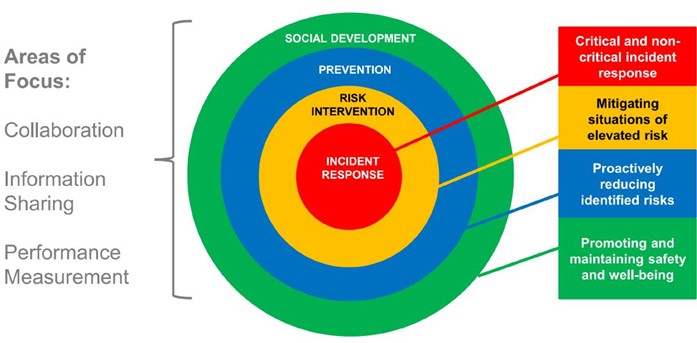Community Safety and Well-Being Plan
The development of this Community Safety and Well-Being Plan was influenced and informed by the passion and dedication of committed community partners and our residents. As a result of their commitment, time, resources, willingness to collaborate, shared knowledge and experience, we have the opportunity to work together to better the lives of our residents.
Our Community Safety and Well-Being (CSWB) Plan is our commitment to work together towards improved social outcomes for our residents. Beyond the legislative requirements for the Plan under Bill 175, Safer Ontario Act (2018), this plan looks at tackling tough social issues from a different angle. Our Plan identifies and lays the foundation for local social development priorities over four years (2021- 2025). Just as the areas of risk identified in our local Plan are intricately connected, our Plan is also connected to other CSWB planning taking shape across our county. We recognize and value the role that planning locally and planning together brings to our objectives. We share common goals but appreciate that the needs and how we move forward can be unique to each community. We will leverage and support the many existing initiatives that advance safety and well-being.
Community safety and well-being is the ideal state of a sustainable community where everyone is safe, has a sense of belonging, opportunities to participate, and where individuals and families are able to meet their needs for education, health care, food, housing, income, and social and cultural expression.
While we celebrate what makes the municipalities of Simcoe County great, we recognize that not every resident enjoys the same quality of life. There are factors and characteristics in our lives that either hinder or help us. Depending on these factors and circumstances, residents may find themselves struggling to achieve education, find work, having to decide if they pay for their housing or put food on the table, feeling disconnected and alone, struggling every day with mental health or addiction, or wondering where they can find the help they need and how they will carry on. Many of those mentioned above are considered to be among the social determinants of health. The social determinants of health are the collective set of personal, social, economic and environmental factors that determine a person’s health. Where we are born, grow up, live, work, and age also influence our health and well-being.
The circumstances surrounding the determinants of health are complex. Often, police find themselves responding to calls that are complex but not criminal with no chargeable offences. The police are available to the public 24/7, but that does not mean that they are the most appropriate to respond to calls that are often medically or socially complex. In looking at root cause, there is a clear indication that all sectors have a shared responsibility to support our residents’ safety and well-being.
The Government of Ontario has demonstrated its commitment to supporting communities by developing a provincial approach to community safety and well-being. Under the Province of Ontario’s Bill 175, Safer Ontario Act (2018), the Ministry of the Solicitor General requires that the Council of every municipality shall prepare and, by resolution, adopt a Community Safety and Well-Being (CSWB) Plan on or before July 1, 2021. The CSWB Plan will address local needs based on local risk factors. This type of planning is intended to focus on upstream strategies. By examining and addressing root causes rather than just the symptoms, we can improve the lives of residents in our community by changing outcomes specific to health, well-being and safety.

Social Development
Promoting and maintaining community safety and well-being. This is where a wide range of sectors, agencies, organizations and those with lived experience bring different perspectives to the table to address complex social issues from every angle. Strategies need to be put in place that target the root causes of these issues.
Prevention
Reducing identified risks. Proactively implementing evidence-based situation measures, policies or programs to reduce locallyidentified priority risks to community safety and well-being before they escalate and result in crime, victimization and harm.
Risk Intervention
Mitigating elevated risk situations. Risk intervention is intended to be immediate and prevent an incident. Multiple sectors work together to address situations where there is an elevated risk of harm – stopping something bad from happening before it is about to happen.
Incident Response
Immediate response to urgent incidents This includes immediate and reactionary responses that may involve a sense of urgency like police, fire, emergency medical services, a child welfare organization taking a child out of their home, a person being apprehended under the Mental Health Act, or a school principal expelling a student.
Township of Essa
5786 Simcoe County
Road 21, Utopia, ON
L0M 1T0
Phone: 705-424-9770
Fax: 705-424-2367
TTY: 705-424-5302
